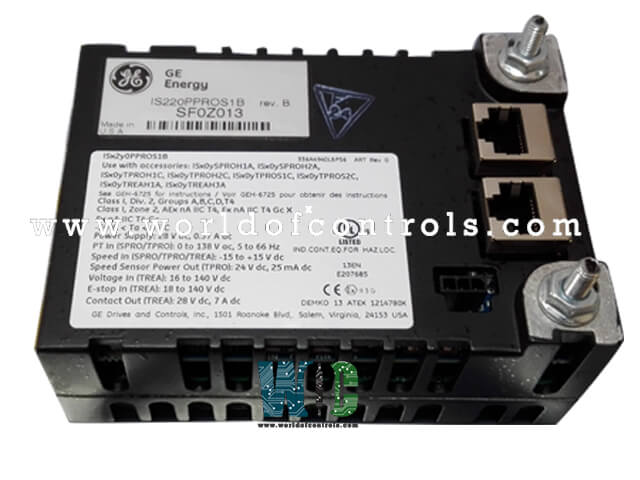
World Of Controls understands the criticality of your requirement and works towards reducing the lead time as much as possible.
IS220PPROS1B - Emergency Turbine Protection I/O Pack is available in stock which ships the same day.
IS220PPROS1B - Emergency Turbine Protection I/O Pack comes in UNUSED as well as REBUILT condition.
To avail our best deals for IS220PPROS1B - Emergency Turbine Protection I/O Pack, contact us and we will get back to you within 24 hours.
SPECIFICATIONS:
Part No: IS220PPROS1B
Manufacturer: General Electric
Product Type: Emergency Turbine Protection I/O Pack
Series: Mark VIe
Operating temperature: -30 to 65oC
Power Supply Voltage: 24 V dc
Board Size: 14.3 cm high x 23.1 cm
Weight: 0.45 kg
Availability: In Stock
Country of Origin: USA
Manual: GEH-6721L
FUNCTIONAL DESCRIPTION:
IS220PPROS1B is an Emergency Turbine Protection I/O Pack manufactured and designed by General Electric as part of the Mark VIe Series used in GE Distributed Control Systems. A backup Overspeed protection system with a backup check for generator synchronization to a utility bus is provided by the Emergency Turbine Protection I/O pack (PPRO) and related terminal boards. They also serve as the primary control's independent watchdog. Three triple modular redundant (TMR) PPRO I/O packs mounted to a separate simplex protection (SPRO) terminal board make up a typical protection system. Each SPRO is connected to the designated emergency trip board by a cable with DC-37 pin connections on both ends:
A single-board TMR protection system using three PPRO I/O packs is possible in a different configuration. The PPRO connects to the control modules via Ethernet for IONet communications. The primary and backup trip systems for the Mark* VIe control are integrated at the trip terminal board level. The Turbine Primary I/O pack, PTUR, which uses a primary trip board, provides primary protection (TRPG, TRPL, TRPS, TRPA). The PPRO I/O pack operates a backup trip board to provide backup protection (TREG, TREL, TRES, TREA).
COMPATIBILITY:
Direct mounting on SPRO or TREA is supported by PPROH1A. It is cable-compatible with TREG, TREL, and TRES when placed on SPRO.
SIMPLE MAIN CONTROL:
The Mark VIe trip board TRES supports simplex backup protection. The controller IONet has one PPRO network port. All Mark VIe backup trip boards, TREG, TREL, TREA, and TRES, feature TMR backup protection. In this setup, the controller IONet is connected to one port on each of the three PPRO I/O packs.
DUAL MAIN CONTROL:
The Mark VIe trip board TRES supports simplex backup protection. The R controller is connected to the network first when this setup is used. The S controller is accessible via the second network connection. Then, PPRO is in charge of overseeing the performance of both controllers. The pack trips if either controller fails, or both controllers fail, according to PPRO.
INSTALLATION:
The Mark VIe SPRO or TREA terminal board accepts the PPRO's direct mounting. Cables with DC-37 pin connections on both ends are necessary between the SPRO board and the chosen trip terminal board when placed on an SPRO board. The following are the installation steps:
OPERATION:
The I/O pack or module function-specific acquisition board is connected to the processor board. The soft-start circuit ramps up the voltage available on the processor board when input power is applied. The processor reset is turned off and the local power supply is turned on in order. After finishing self-test routines, the processor loads application code from flash memory that is particular to the I/O pack or module type. To verify that the application code, acquisition board, and terminal board are correctly matched, the application code reads the board ID information. When there is a good match, the processor makes an effort to start Ethernet connections by asking for a network address.
The whole circuitry required to enable the I/O pack to function from one or two Ethernet inputs is contained in the processor application code. Both network pathways are constantly active when two Ethernet inputs are used. The I/O pack or module operation will not be hampered by a failure of either network, and the functioning network connection will reveal the failure. Compared to a traditional hot-backup system, where the second port is only used when the primary port fails to function, this configuration is more fault tolerant. The processor's Ethernet ports automatically negotiate between half-duplex and full-duplex operation at speeds between 10 MB/s and 100 MB/s. Each Mark VIe Ethernet I/O pack or module shares a processing board. It has the following in it:
WOC has the largest stock of GE Distributed Control replacement spare parts. We can repair your faulty boards. WORLD OF CONTROLS can also supply unused and rebuilt backed-up with a warranty. Our team of experts is available round the clock to support your OEM needs. Our team of experts at WOC is happy to assist you with any of your automation requirements. For pricing and availability on any parts and repairs, kindly get in touch with our team by phone or email.
FREQUENTLY ASKED QUESTIONS:
How to Check Price and Availability For IS220PPROS1B?
Please Contact World of Controls FZE for sales at +1 609 385 1231 or Request a Quote.
What Payment Options do You Accept?
Bank Transfer is the preferred payment method. For more payment options contact us.
How are boards packaged for shipment from WOC?
Parts are placed in antistatic packets and securely packed in ESD boxes cushioned with ESD Foam designed to safeguard electrical components.